Stretch ceilings are a modern and practical type of finishing that allows you to hide flaws and defects in the main ceiling, as well as create a beautiful and stylish interior. But how do you choose the best stretch ceiling from the many options offered on the market? What materials, textures, colors and shapes are suitable for different rooms and styles? What are the advantages and disadvantages of stretch ceilings compared to other types of finishes? And what do experts and real buyers have to say about this? In this article we will try to answer all these questions and help you make the right choice.
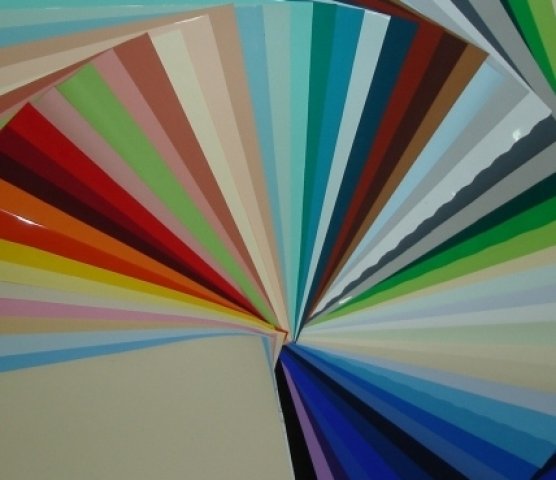
Types of materials for stretch ceilings
Two main types of materials are used for installing stretch ceilings: PVC film and polyester fabric. Each has its own characteristics, advantages and disadvantages to consider when choosing.
PVC Ceilings
PVC ceilings are a thin polymer film that is stretched over a special profile (cornice) using a heat gun. PVC ceilings come in different textures: glossy, matte, satin, pearly, metallic, photo printed, etc. They can also have different colors and shades, including non-standard ones like gold, silver, bronze, etc.
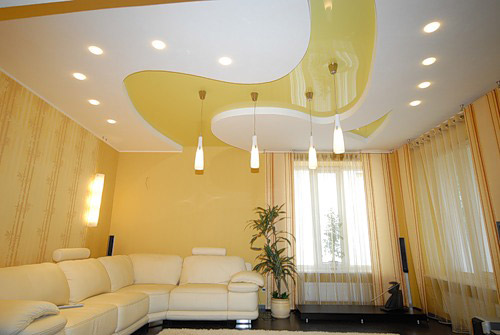
Advantages of PVC ceilings:
- Water resistance. PVC ceilings do not let water through and can withstand flooding from upstairs neighbors. After pumping out the water, they return to their original condition.
- Air tightness. PVC ceilings do not let in dust, dirt, odors and allergens, creating a comfortable microclimate in the room.
- Durability. PVC ceilings can withstand heavy loads and impacts without tearing or deforming.
- Fire safety. PVC ceilings are non-combustible and do not promote the spread of fire. They also do not release toxic substances when heated.
- Versatility. PVC ceilings are suitable for any room, including bathrooms, kitchens, balconies and loggias. They also allow you to create different shapes and structures: single-level, multi-level, domed, arched, etc.
- Wide range of designs. PVC ceilings come in a variety of textures, colors and patterns to suit any style and taste.
Disadvantages of PVC ceilings:
- Requires heating. PVC ceilings are installed using a heat gun which heats the film to 60-80°C. This can cause some inconvenience and discomfort for residents and furniture.
- Reduced ceiling height. PVC ceilings take 3 to 10 cm from the base ceiling, depending on the profile type and design. This can be critical for rooms with low ceilings.
- Difficult to dismantle. PVC ceilings are difficult to remove without damaging the film and profile. If you need to replace or repair the canvas, you will need to call in specialists.
- Possibility of fading. PVC ceilings can lose color and gloss under sunlight or artificial lighting. This is especially true for bright and non-standard shades.
Artistic film ceilings (photo decor) are a creative solution – not only does the ceiling have an original shape and color, but pictures are depicted on it (day/night sky, bouquets, landscapes), abstractions. Such ceilings do not differ in quality or need for additional care from classic ones, but they are significantly more expensive.
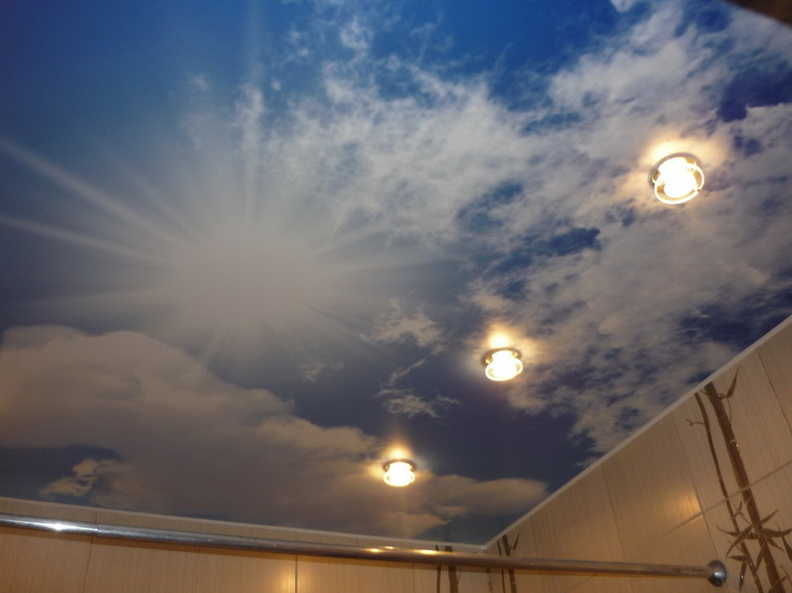
Fabric Ceilings
Fabric ceilings are a sheet of synthetic fabric (polyester) that is stretched over a profile without heating. Fabric ceilings can be solid colored or photo printed. They have a matte or slightly silky surface.

Advantages of fabric ceilings:
- Eco-friendliness. Fabric ceilings do not emit harmful substances and are odorless. They also allow air to pass through, promoting natural ventilation of the room.
- Resistance to temperature changes. Fabric ceilings do not react to changes in temperature and humidity, so they are suitable for unheated spaces such as balconies, loggias, verandas, etc.
- Easy installation and dismantling. Fabric ceilings are installed without heating, simplifying and speeding up the installation process. They are also easily removed and reinstalled if necessary.
- Seamlessness. Fabric ceilings are made from a single canvas up to 5 meters wide, so they have no visible seams or joints. This creates the effect of an even, smooth ceiling.
- Long canvas length. Fabric ceilings can be up to 50 meters long, allowing them to cover large areas without additional joints.
Disadvantages of fabric ceilings:
- High cost. Fabric ceilings are more expensive than PVC ceilings, as they require higher quality materials and complex installation equipment.
- Limited design choices. Fabric ceilings offer fewer texture, color and pattern options than PVC ceilings. They also do not lend themselves to complex shapes and structures like domes, arches, etc.
- Difficult to repair. Fabric ceilings cannot be repaired if damaged, and are difficult to clean from stains. If noticeable stains, holes or tears appear on the canvas, it will need to be replaced entirely.
Reviews and expert opinions on stretch ceilings
To find out which stretch ceilings are best to choose, you can also refer to reviews and expert opinions from those with experience working with different types of materials and designs. We’ve collected some quotes from various sources to help give you an idea of the pros and cons of stretch ceilings.
Buyer Reviews
- “We installed a glossy PVC ceiling in the living room and are very happy with the result. The ceiling looks very beautiful and bright, reflects light and enlarges the space. The installation was quick and neat, without mess or smell. We recommend!”
- “We have a fabric ceiling with photo printing in the bedroom. The canvas is high quality, does not fade or stretch. The picture is very realistic, creating a presence effect. We chose an image of the sky with clouds, it’s very relaxing and soothing.”
- “I do not advise installing a PVC ceiling in the kitchen. We had a matte white ceiling which after a year began to yellow and get stained from grease and steam. We had to change it to fabric, which is easier to clean and does not change color.”
Expert Opinions
- “PVC ceilings are the most popular and affordable type of stretch ceiling on the market. They have many advantages such as water resistance, air tightness, durability, fire safety and a wide range of designs. However, they also have some disadvantages such as the need for heating, reduced ceiling height, difficult dismantling and potential for fading. So when choosing a PVC ceiling, you need to consider all these factors and choose a suitable option for the specific room and style.”
- “Fabric ceilings are a more expensive and exclusive type of stretch ceiling that differs from PVC ceilings in several ways. They are more eco-friendly, resistant to temperature changes, easy to install and dismantle, seamless and have a longer canvas length. However, they also have disadvantages such as high cost, limited design choices, and inability to repair. So when choosing a fabric ceiling, you need to be prepared for it to serve a long time without problems, but also cost more and have fewer design options.”
How to choose a stretch ceiling for your home
So we’ve looked at the main types of materials for stretch ceilings, their advantages and disadvantages, as well as reviews and expert opinions. Now you can make a more informed and reasoned choice for your home. But what criteria should you consider when choosing a stretch ceiling? Here is some advice to help you decide:
- Set a budget. Stretch ceilings vary in cost depending on the material type, texture, color, pattern, shape and installation complexity. PVC ceilings are usually cheaper than fabric ones, and glossy cheaper than matte or photo printed. Compare prices from different companies and choose the one that offers the best value for money.
- Assess the room’s specifics. Stretch ceilings are suitable for any room, but depending on their function and size you can choose a more suitable option. For example, waterproof, easy to clean PVC ceilings are better suited for bathrooms and kitchens, while more eco-friendly, comfortable fabric ceilings are preferable for bedrooms and living rooms. For low ceilings, choose glossy or light ceilings that will visually enlarge the space, and for high ceilings, matte or dark ceilings that will create coziness and atmosphere.
- Choose a style and color. Stretch ceilings can have different styles and colors, so you need to pick a variant that will harmonize with the overall interior design and your preferences. For example, for a classic style, single-color or pearly white or beige ceilings will fit well, and for contemporary style, glossy or metallic ceilings in bright or unusual shades. You can also use photo printing to create a 3D effect or imitate natural materials.
- Consider the lighting. Stretch ceilings can be equipped with different types of lighting: spotlights, chandeliers, LED strips, etc. When choosing lighting, consider the ceiling material and texture, as well as the desired effect. For example, glossy ceilings work well with spotlights that will create beautiful reflections and glare, while matte ceilings pair better with chandeliers or LED strips that will evenly distribute light across the surface. You can also combine different lighting types to create different scenarios and moods.
Stretch ceiling installation
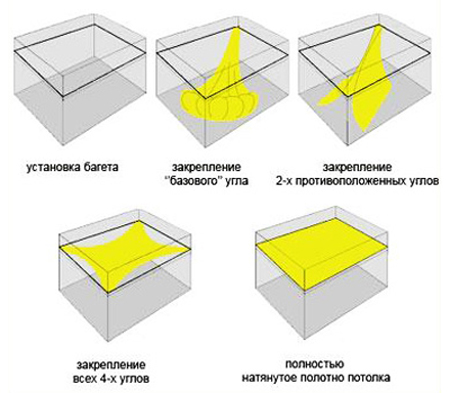
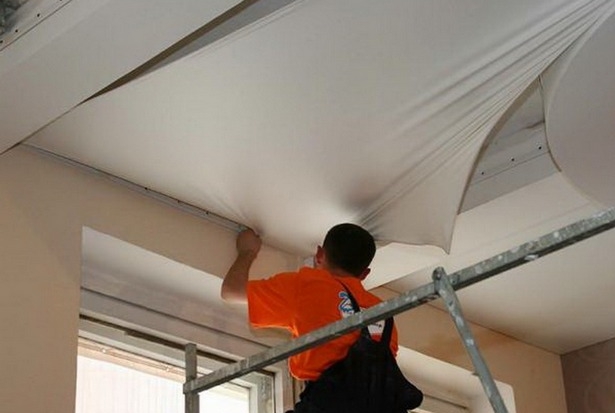
We hope this article has helped you understand which stretch ceiling is best to choose for your home. Stretch ceilings are an excellent way to improve the appearance and comfort of your home, as well as protect it from external influences. Choose the option that suits your budget, room specifics, style and color, and take into account reviews and expert opinions. And remember that the quality and durability of a stretch ceiling depends not only on the material, but also on the professionalism of the installers. So turn only to proven, reliable companies that provide guarantees and service on their work. Good luck with your choice! 😊